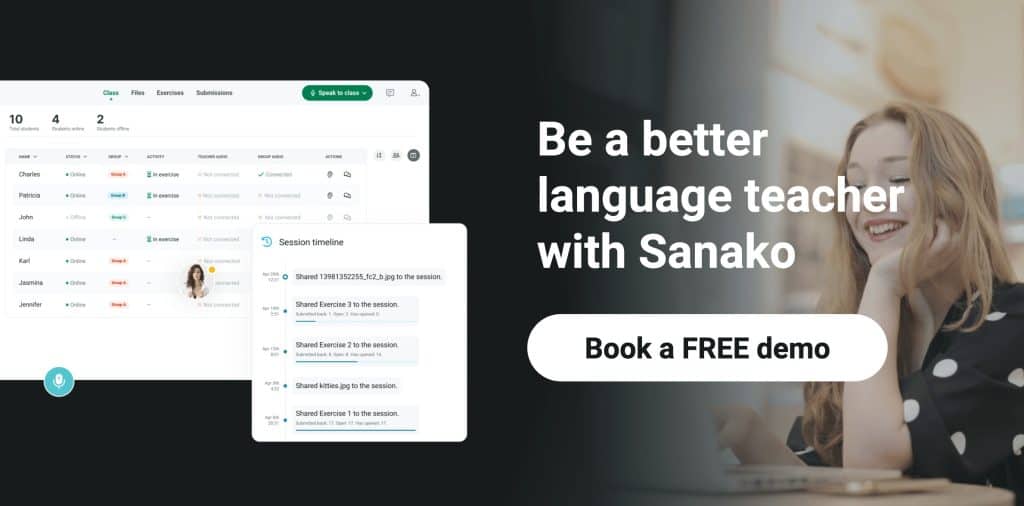As any language educator knows, every student is different. Each has their own motivation, a unique background and their own previous experience (if any!) with their intended target language. It’s part of what makes the job of teaching language skills so unique.
It’s important therefore that teachers take the time to meet the specific language learning needs of each student as they progress through their course. To do this, the very best teachers, either consciously or perhaps often unconsciously, break down student learning process into easily manageable chunks of material that build fluency step-by-step. This process is called scaffolding and this blog post explores how language teachers can scaffolding strategies to best support their Foreign or English language learners and help them build fluency.
What is scaffolding?
The theory behind scaffolding as an educational concept was introduced in the 1970s by Jerome Bruner, a cognitive psychologist. He referred to it as the ‘interactional instructional relationship’ between educators and learners that ‘enables a child or novice to solve a problem […] beyond his unassisted efforts’ (Wood, Bruner and Ross 1976).
Or put more simply – it is a teaching method that provides appropriate assistance to students so that they may achieve something, like problem solving, beyond what they could achieve on their own.
The research on the topic also identifies two key important properties of effective scaffolding in language acquisition. The first is that it has to be systematic to really work – i.e the teacher must provide the student with support that builds on their prior knowledge and experiences as they learn new skills, new words, and new concepts. And secondly, scaffolding is a temporary structure which offers support to access learning, but which is gradually removed as the student masters the assigned skills or tasks.
Sometimes we see the term differentiation used in close context with scaffolding, but even if these two strategies can often be used in conjunction they are not the same. Differentiation customizes instruction for diverse learners in the classroom, adapting content and tasks to individual needs. Scaffolding provides temporary support and guidance to help students learn new skills, gradually decreasing support as they become more independent. Differentiation is about tailoring the learning experience, while scaffolding is about targeted assistance in the learning process.
Why does scaffolding work so well for language learning?
Feedback from educators and researchers suggests that scaffolding is highly effective in engaging and motivating learners. As students are always building on what they know, they are able to be successful before moving into new or unfamiliar territory. As a result, students can clearly see that they are making progress, which decreases frustration and encourages them to keep going.
In addition to supporting learning, scaffolding also:
- Helps students become more independent learners
- Creates a supportive learning environment in which students take a more active role
- Enables teachers to maintain high expectations rather than always simplifying the task
- Focuses attention on the task itself
- Reduces frustration and risk.
How can you use scaffolding strategies in your language classroom?
Broadly the concept of scaffolding is used by educators / institutions at two levels. The macro level focuses on the work of the institution or department as a whole, ensuring that curriculum planning follows the step-by-step, systematic approach to language development outlined above. At the micro level, scaffolding is often referred to as instructional scaffolding, which according to van Lier 2004 is the ongoing support teachers give their students in the classroom.
In every lesson when using scaffolding techniques, educators should begin by ensuring that there is a clear connection between what the students already know and what they are about to learn. Without something to build upon, students can struggle and then often disengage from learning. Once the background knowledge is built and the connection made, the ‘scaffold’ can then be removed.
A good example of this is the importance of previewing or pre-teaching vocabulary in advance of a particular assignment. Without this vital step, it is unrealistic to assume that second language learners can look up words in a dictionary and understand their meaning or contextual use. Direct instruction and pronunciation practice can therefore be helpful to build upon the words / phrases that they already know.
Educators at the Centre for the Collaborative Classroom identify two broad types of scaffolding approaches that are effective in the language classroom. These are:
- Verbal Scaffolds
Always consider how information is verbally presented or explained to the students in the classroom. Tips and tricks to provide better verbal scaffolds include slowing your speech, enunciating clearly and using read-alouds to model correct pronunciation.
- Procedural Scaffolds
Scaffolding can also be incorporated through the content and materials used in learning and in the environment to support students as they progress. Procedural scaffolds can be created through the use of visual aids or graphic organizers such as mind maps and wall charts to help learners understand complicated text and organize information. Discussion prompts such as sentence frames also provide invaluable support and structure so that second language learners can produce sentences on their own.
In their work to overcome exclusion through language education, the Bell Foundation build on the above to identify six easy-to-use teaching strategies that embrace scaffolding instruction in the classroom.
- Modelling and demonstrating language orally or in writing to the learner
- Encouraging learners to occasionally use their native language
- Activating prior knowledge about a new topic to create a context for the new learning
- Incorporating collaborative group or pair work into lessons
- Using visuals and graphic organisers such as pictures, models, diagrams, grids, tables and graphs to support understanding
- Providing language prompts and frames for speaking and writing
How can Sanako help to scaffold language teaching?
As outlined above, scaffolding is particularly important for language learners as it enables them to move from dependent to independent learning. Students are supported to move onto more difficult assignments as their skills develop. All the while, support continues to be scaffolded by the expert educator.
However this interactional scaffolding approach does pose a significant challenge for teachers. Not only do they need to specifically create and plan the proposed scaffolds, but they must also be prepared to address unexpected problems as they arise in the classroom.
The help of dedicated language teaching technologies such as Sanako Connect is therefore highly valued in supporting educators to manage learning and reduce workload.
Educators can use Sanako Connect to scaffold learning by uploading a wide variety of material for students to work through during their activities. Any number of sound files, PDFs, presentations, videos and web pages can, for example, be easily attached to an online lesson. Connect also provides tools and different task types for teachers to mix and match to design the type of exercises they’d like to create. This includes common language teaching assignments including multiple choice quizzes or pronunciation activities. It also facilitates gap fill exercises, which can be a powerful scaffold for language learners to use when practising specific grammatical structures.
Importantly, all of the content that educators create in Sanako Connect can be easily saved in the cloud for future use. Resources can be easily reused and repurposed for different students, different age groups or for different classes. There’s no need to create everything from scratch every time. Importantly, teachers in the same institution can also easily share materials and exercises they have created with their colleagues.
Collaborative conversation, in pairs or a group, with learners of mixed ability and backgrounds can also be a useful way to scaffold and build speaking skills in a foreign language. Again Sanako has been specifically developed to support this as it allows educators to easily divide students into pairs or small groups for live conversation practice in the classroom as well as remotely. In Sanako Connect, each group of students can talk simultaneously without distracting each other. Teachers can listen in or talk with different groups to assist as required. All of these separate group conversations can be easily recorded and reviewed by both students and teachers. Educators can also use Connect to provide precisely time-coded audio and written feedback.
If you’d like to find out more about how Sanako Connect could help your institution to better scaffold its language teaching, please contact us now for more information and to arrange your FREE demo!
This blog post was last updated 17 October, 2023.


